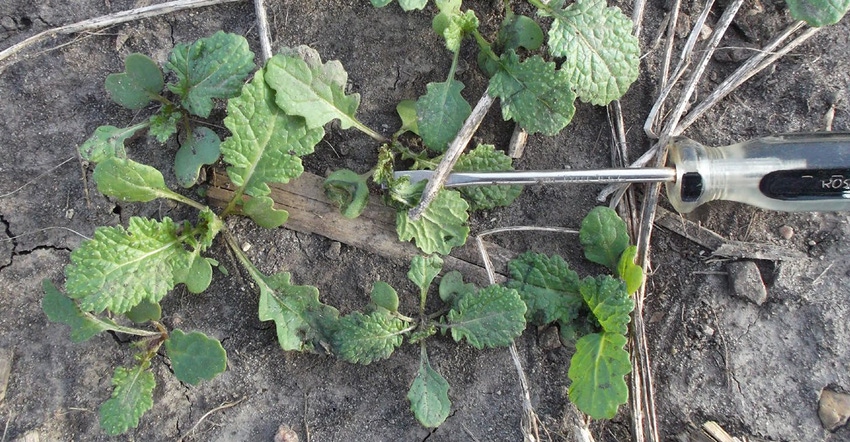November 22, 2017

By Alisha Bower
In Iowa, the most common cover crops are winter cereals like rye or wheat, sown in the fall near corn and soybean harvest, but some pioneering farmers are investigating the viability of planting cover crops in the early spring. New studies from Practical Farmers of Iowa investigated several different varieties of spring sown brassica cover crops and found that mustard provided the most ground cover and the benefits of using this strategy are closely linked to higher numbers of growing degree days (GDDs).
There are several different reasons why a farmer might want to put out a spring cover crop.
Chris Teachout, farming near Shenandoah in southwest Iowa, asked himself, “How can I get diversity? In a corn-soybean rotation, unless you get your cover crop in early before Oct. 1, then it’s hard to get diversity. You can only really do oats, wheat or cereal rye. So come spring, what I did was a 12- to 15-way blend with oats barley, flax, mustard, spring peas. And we put this mixture out there as early as possible, when old-timers would plant their oats.”
Increased benefits with cover mix
Teachout sees many benefits of this. “You maybe only get 40, 45, 50 days, and you won’t have a lot of biomass aboveground, but it’s putting a lot of fibrous roots below- ground that break up compaction, hold up equipment. So it’s really nice to drive on, and we can give a nutrient and biology bump to our soils.”
In the spring 2017 farmers Chad Ingels, Randalia; Steve McGrew, Emerson; and Jeremy Gustafson, Boone, wanted to conduct a rigorous on-farm research trial to quantify these benefits of cover crops. They designed their spring-seeded cover crop study to measure ground cover — a key element of both erosion control and weed suppression.
These farmers chose brassica species to test because they are cool-season plants that have potential to thrive in the February-April window, and the seed size is very similar to red clover, which is commonly frost-seeded with success in this region. An agronomic benefit of brassica cover crops is that their long taproots are excellent for breaking up compaction in the field.
Unfortunately, in many parts of Iowa, brassicas don’t have enough GDDs to establish that deep taproot if they are planted after corn and soybean harvest. So planting them in the spring for a 40- to 50-GDD window may be a more effective strategy for harnessing these compaction-busting benefits, depending on the region you’re in.
Mustard outperforms
Each farmer planted three brassica species — one variety of mustard, one variety of rapeseed and then a third variety of either radishes or turnips.
Of the three varieties, mustard performed the best in terms of creating ground cover in each location. Varieties of mustard included in the trial were Kodiak Mustard and Pacific Gold Mustard.
The largest seeds were from Daikon Radish, which completely failed to establish, so the small seed size of rapeseed, mustard and turnip appear to be a key factor in successfully frost-seeding these crops.
Another key aspect of the study is all three farms are dispersed geographically throughout Iowa. Across the locations, the farmers farther south saw proportionally more ground cover.
McGrew, whose farm was farthest south, had the greatest ground cover. Ingels, who farms farthest north of the three, saw the lowest ground cover rates.
“I’m always glad to try something and see what comes out of it,” says Ingels. “You know going in it may or may not work, so you try to give it a shot and see what happens. From my perspective, in my part of the state, spring-seeded covers are a waste of time. We didn’t get a lot of biomass and cover, so it wasn’t worth the expense.”
About his farm in Fayette County in northeast Iowa, he says, “From doing fall seeded trials, I’ve learned that just a simple rye or wheat seeding in the fall works well here. It’s the simplest and you feel you’ve got something out of it because you get a good amount of growth in the fall, and it really takes off in the spring before a spring seeded cover would even get started.”
Spring-seeded brassicas
But for farmers located in southern Iowa, these research findings show spring-seeded brassicas can be an effective strategy to achieving some cover cropping goals.
As a next step, “I might try this on a larger scale and try to plant the cover crop sooner,” McGrew says.
“This technique might fit where the fall-seeded broadleaf cover crops don’t overwinter well. I’m considering planting a winterkill grass like oats or barley and then maybe mustard and rapeseed broadcast during the winter before corn,” he points out.
This approach would keep the ground covered for more of the year for farmers who want to avoid the potential yield-drag that winter-hardy grasses can have on the following corn crop.
You can read the full report on spring seeded brassica cover crops at practicalfarmers.org/research-reports.
Are you interested in conducting your own on-farm research? Support for conducting paid, on-farm research is one of the benefits of a membership with Practical Farmers of Iowa.
To learn more about membership or to join, go online to practicalfarmers.org/join.
Bower is the Midwest Cover Crop Associate for PFI, located in Ames.
You May Also Like




